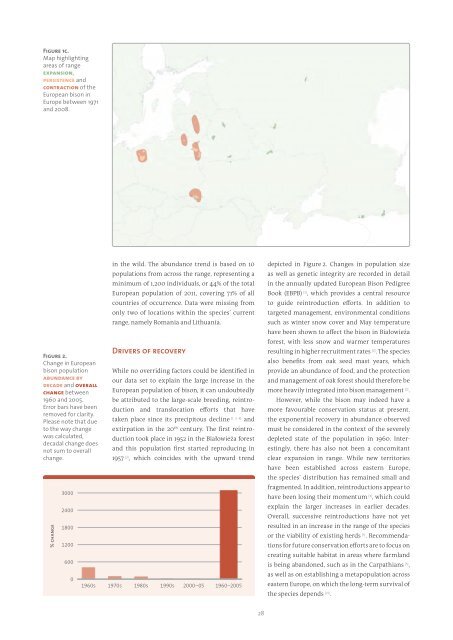130925-studie-wildlife-comeback-in-europe
You also want an ePaper? Increase the reach of your titles
YUMPU automatically turns print PDFs into web optimized ePapers that Google loves.
Figure 1c.<br />
Map highlight<strong>in</strong>g<br />
areas of range<br />
expansion,<br />
persistence and<br />
contraction of the<br />
European bison <strong>in</strong><br />
Europe between 1971<br />
and 2008.<br />
Figure 2.<br />
Change <strong>in</strong> European<br />
bison population<br />
abundance by<br />
decade and overall<br />
change between<br />
1960 and 2005.<br />
Error bars have been<br />
removed for clarity.<br />
Please note that due<br />
to the way change<br />
was calculated,<br />
decadal change does<br />
not sum to overall<br />
change.<br />
% change<br />
3000<br />
2400<br />
1800<br />
1200<br />
600<br />
0<br />
<strong>in</strong> the wild. The abundance trend is based on 10<br />
populations from across the range, represent<strong>in</strong>g a<br />
m<strong>in</strong>imum of 1,200 <strong>in</strong>dividuals, or 44% of the total<br />
European population of 2011, cover<strong>in</strong>g 71% of all<br />
countries of occurrence. Data were miss<strong>in</strong>g from<br />
only two of locations with<strong>in</strong> the species’ current<br />
range, namely Romania and Lithuania.<br />
Drivers of recovery<br />
While no overrid<strong>in</strong>g factors could be identified <strong>in</strong><br />
our data set to expla<strong>in</strong> the large <strong>in</strong>crease <strong>in</strong> the<br />
European population of bison, it can undoubtedly<br />
be attributed to the large-scale breed<strong>in</strong>g, re<strong>in</strong>troduction<br />
and translocation efforts that have<br />
taken place s<strong>in</strong>ce its precipitous decl<strong>in</strong>e [1, 3, 4] and<br />
extirpation <strong>in</strong> the 20 th century. The first re<strong>in</strong>troduction<br />
took place <strong>in</strong> 1952 <strong>in</strong> the Białowieża forest<br />
and this population first started reproduc<strong>in</strong>g <strong>in</strong><br />
1957 [3] , which co<strong>in</strong>cides with the upward trend<br />
1960s 1970s 1980s 1990s 2000–05 1960–2005<br />
depicted <strong>in</strong> Figure 2. Changes <strong>in</strong> population size<br />
as well as genetic <strong>in</strong>tegrity are recorded <strong>in</strong> detail<br />
<strong>in</strong> the annually updated European Bison Pedigree<br />
Book (EBPB) [3] , which provides a central resource<br />
to guide re<strong>in</strong>troduction efforts. In addition to<br />
targeted management, environmental conditions<br />
such as w<strong>in</strong>ter snow cover and May temperature<br />
have been shown to affect the bison <strong>in</strong> Białowieża<br />
forest, with less snow and warmer temperatures<br />
result<strong>in</strong>g <strong>in</strong> higher recruitment rates [2] . The species<br />
also benefits from oak seed mast years, which<br />
provide an abundance of food, and the protection<br />
and management of oak forest should therefore be<br />
more heavily <strong>in</strong>tegrated <strong>in</strong>to bison management [2] .<br />
However, while the bison may <strong>in</strong>deed have a<br />
more favourable conservation status at present,<br />
the exponential recovery <strong>in</strong> abundance observed<br />
must be considered <strong>in</strong> the context of the severely<br />
depleted state of the population <strong>in</strong> 1960. Interest<strong>in</strong>gly,<br />
there has also not been a concomitant<br />
clear expansion <strong>in</strong> range. While new territories<br />
have been established across eastern Europe,<br />
the species’ distribution has rema<strong>in</strong>ed small and<br />
fragmented. In addition, re<strong>in</strong>troductions appear to<br />
have been los<strong>in</strong>g their momentum [3] , which could<br />
expla<strong>in</strong> the larger <strong>in</strong>creases <strong>in</strong> earlier decades.<br />
Overall, successive re<strong>in</strong>troductions have not yet<br />
resulted <strong>in</strong> an <strong>in</strong>crease <strong>in</strong> the range of the species<br />
or the viability of exist<strong>in</strong>g herds [5] . Recommendations<br />
for future conservation efforts are to focus on<br />
creat<strong>in</strong>g suitable habitat <strong>in</strong> areas where farmland<br />
is be<strong>in</strong>g abandoned, such as <strong>in</strong> the Carpathians [5] ,<br />
as well as on establish<strong>in</strong>g a metapopulation across<br />
eastern Europe, on which the long-term survival of<br />
the species depends [21] .<br />
28


